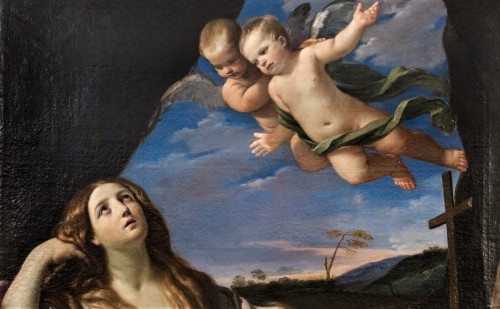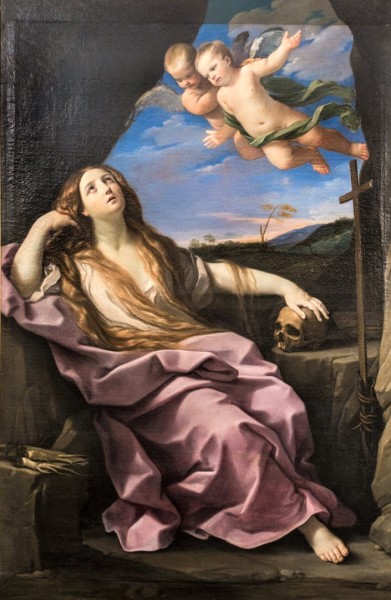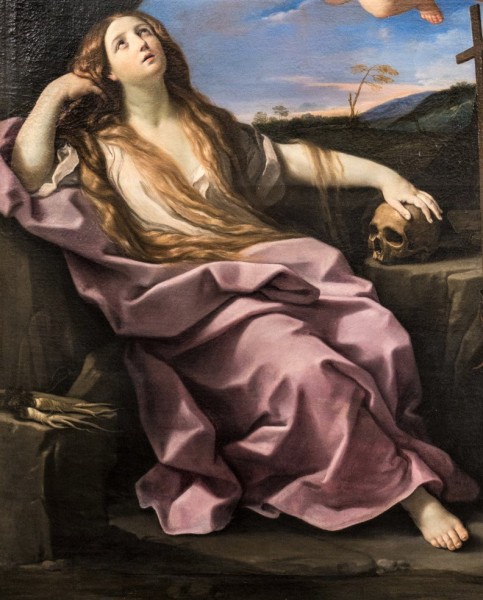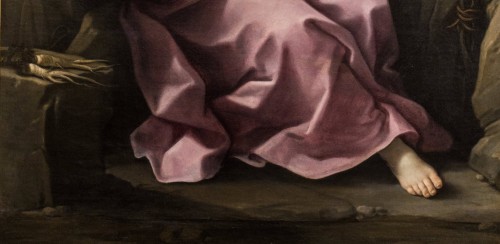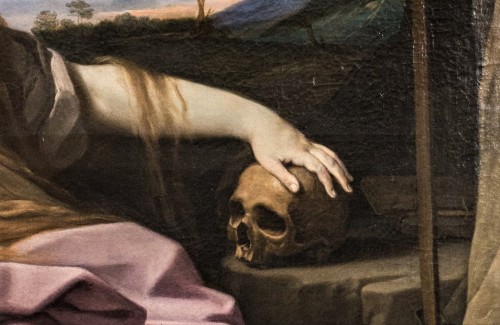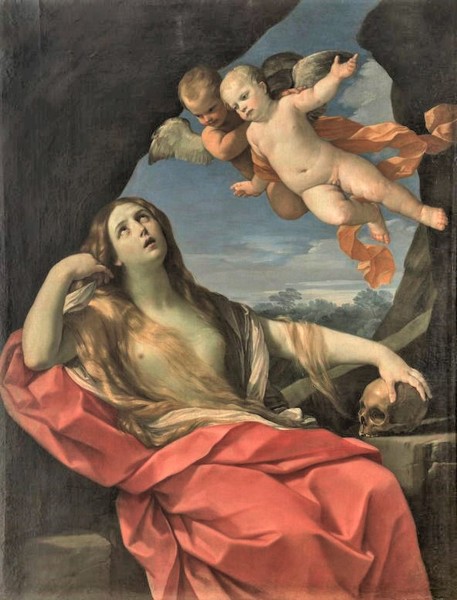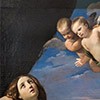Cardinal Antonio Santacroce, who came from the Roman aristocracy, was in the years 1631-1634 the papal legate in Bologna. He took up this distinguished post due to Pope Urban VIII, but above all due to his nepot and nephew – Cardinal Francesco Barberini, with whom Santacroce had attended Collegio Romano. It was thanks to him that the young at that time thirty-year-old clergyman became a cardinal (1629) and enjoyed a rapid rise in the ranks of the Church. But also thanks to Francesco Barberini and his circle of friends, made up of numerous art collectors, the cardinal acquired a taste for art. And it was in Bologna that he became interested in contemporary artists, among whom there was also the Bologna-born painter, who enjoyed great fame at the time due to his talents, Guido Reni. It was from him that Santacroce ordered a painting depicting the penitent Mary Magdalene, and this was no accident since it was a similar image to the one that was commissioned from Reni (Penitent Mary Magdalene, 1627) for his private collection by Santacroce’s friend and patron Barberini.

Mary Magdalene had been at that time one of the most popular painting topics, which can be testified to by the pendant of the aforementioned painting by Reni, in the Palazzo Barberini (Penitent Mary Magdalene, Charles Mellin). It was not only the topic that was applauded but also the repeating composition scheme. A further testimony to the popularity of this motif is the fact, that only in Reni's workshop approximately fifty paintings were created showing the repenting Mary Magdalene. They are of varied quality – the one painted for Cardinal Antonio Santacroce is one of the best.
After his successful stay in Rome around 1614, Reni moved to Bologna and he set up a workshop there, employing approximately eighty aides. He became an independent painter and experienced a period of true glory. Collectors, art enthusiasts, cardinals, and crowned heads of state all flocked to his workshop. His paintings were sought after, while his nickname “Divino” (Divine), seemed to best reflect the status which he enjoyed. The painter led a life of a true celebrity. And while he was showered with praise and fame, money was not something he had a lot of, frequently spending it either on charity or one of his main vices – gambling.

Let us then look at the painting, which in the past was quite appealing, but today raises mixed feelings, seemingly disproving the saying that good art will always defend itself. Upon the painting there is a fair-haired, corpulent, young, beautiful woman with her gaze directed upwards, who is experiencing – as can be assumed – a rather difficult to describe emotional state, caught in a limbo between ecstasy and nostalgia. Our eyes are drawn to her spiritual face and unwittingly we follow her gaze. The cross hanging in her grotto (the symbol of sacrifice and repentance) as well as the indispensable in such type of iconographic representations of the time, skull (the symbol of the fleetingness of human life) complete the scene, along with the roots visible on the left, with which the hermit was reportedly able to sustain herself and which remind us of fasting – an indispensable element of penitence and asceticism. However, apart from that, it is difficult to find elements that would suggest an ascetic lifestyle. Neither the corpulent, well-taken-care-of body of the protagonist nor her shining hair and well-kept clothes would suggest it, and even the landscape behind her back – a slightly hill terrain with a lot of blue skies, does not bring to mind a hermit's life. And it is upon this concept that the fame of Reni is based – a painter who depicts a saint hermit, eating roots and repenting, yet she is free of the dirt and neglect; she looks as if she had just got up from a comfortable bed and not yet fully awakened, she is lost in thought about something that she had dreamt of. In her thoughtfulness, she is accompanied by two putti (heavenly messengers), who according to a legend visited Mary Magdalene and told her of heaven that awaited her – and towards which she is lovingly gazing. They fed her and “received” her prayers.
Magdalene's body is covered with a white shirt and a pink and violet cascading robe covering it, which merges into one with the rocks of the grotto surrounding her. The uncovered parts of the body and the bare foot are slightly illuminated which provides them with exceptional softness and delicateness. The light – coming in from the left top corner – makes her skin appear even whiter, and brightens her hair and robe and only after a moment's passage do we realize that its source is found not outside but within the hermit's grotto. The wind which seems to be moving the ribbons around the body of one of the putti, also comes from within, as if the whole scene was accompanied by a divine draft of air. Are we not under the impression that we are taking part in something very intimate yet at the same time transcendental?

We can have no doubts, that Reni allows us to look upon the saint at the moment when she is becoming one with God, also known as ecstasy, and even transports us within the boundaries of the miracle in which the saint is participating. The artist shows the religious elation experienced by Magdalene, but the painting is bereft of exaggeration and exaltation, but above all ugliness, coarseness, and dirt that would ruin our image of this wondrous encounter. It fits in perfectly with the post-Trent period in which the vision of divine presence and divine truth was expressed mainly in mass-produced idealized images of saints – intercessors and divine guides on the path towards the salvation of each of the faithful. Reni elevated Magdalene from earthliness to divinity and let her experience divine love. And so she seems to be stuck between sacrum and profanum, dreaming, absent, while the onlooker, following her “heavenly gaze” also experiences divine love. Is it possible to imagine anything that would have a greater impact on individual faith?
The ennobled images of the beautiful penitent Mary Magdalene that speak to us from numerous Baroque paintings, also bore yet another important message – the experience of Divine love is bestowed upon all, even a sinner, since that is how the saint was often seen. Mary Magdalene was the embodiment of the sin of immorality and was identified (and still is today) with a converted prostitute. This unsubstantiated accusation was first made in the VI century, when a faithful student of Christ from the New Testament, who accompanied him until his crucifixion and was the first to see the Resurrected Lord, was combined with the figure of the sinner. Thus an imaginary figure of a saint sinner was created, who in subsequent centuries did not enjoy great popularity. This changed at the time of struggles against Reformation and a crisis within the Church which resulted in the Council of Trent. There the impact of the images of saints on the strengthening of individual faith was discussed and Mary Magdalene was given the role of one such spiritual guide. She gave the onlooker a feeling of participation in the divine union, in a perfect way embodying and showing the sense of penitence and conversion.

In comparison with other images of Mary Magdalene created at that time (see: Magdalene Fainting, Guido Cagnacci), Reni's painting does not emanate excessive sexuality; the woman does not bare her breasts and does not tempt with a daring pose. The painter shows us a figure that is almost etheric, completely idealized, in which corporality is not dominant but neither is it camouflaged. Thus, it creates an ideal balance between sensual charm and spiritual elevation.
However, it was not the choice of topic that brought Reni his fame. His contemporaries were enthralled with the sublime color scheme of his paintings, the chromatic harmony, the skillful use of chiaroscuro, delicate, soft contours, and the modeling of the figures along with the typical poses of their heads and bodies, taken from ancient art, but also seen in the exceptional works of Raphael. The value of Reni's works is in no way diminished by the fact that his figures always took on the same poses (gazing eyes), compositions repeated the same iconographic schemes and even the fact that subsequent canvases had very little of Reni and a lot of his collaborators. This did not cause the artist any headaches, as he claimed – in a truly modern way – that regardless of the fact how many paintings are created in his workshop and who finishes them, the most important is the divine idea behind the works, and by no means did he think about his own talent, but rather about the divinity emanating from his canvases, which he could so exceptionally bring forth.
The paintings from Reni's Bologna period were considered unattainable, otherworldly, and even transcendently beautiful. Today, in many of them we can see too much sentimentality, which is only a step removed from kitsch. And while Reni greatly contributed to the development of religious painting in subsequent centuries, he was also the one who struck the fatal blow. His saints who were to transport the viewer to the borders of marvelousness, heavily copied in the following centuries flooded the interiors of churches throughout the Catholic world. Frequently bereft of artistic valor and finesse of the works of Reni, they focused solely on “forced” religious exaltation.
The Penitent Magdalene, Guido Reni, 1631–1632, oil on canvas, 234 cm x 151 cm, Galleria Nazionale d’Arte Antica, Palazzo Barberini
If you liked this article, you can help us continue to work by supporting the roma-nonpertutti portal concrete — by sharing newsletters and donating even small amounts. They will help us in our further work.
You can make one-time deposits to your account: Barbara Kokoska BIGBPLPW 62 1160 2202 0000 0002 3744 2108 or support on a regular basis with Patonite.pl (lower left corner)
Know that we appreciate it very much and thank You !

